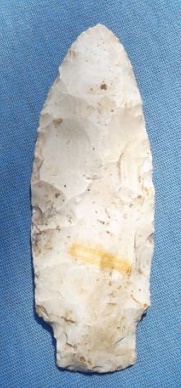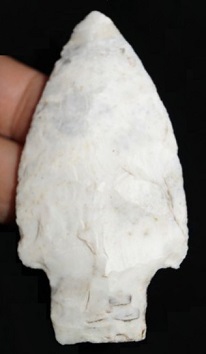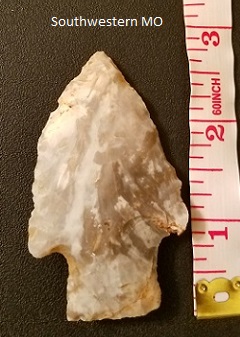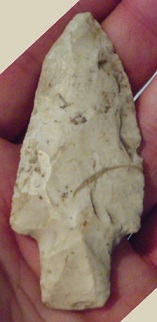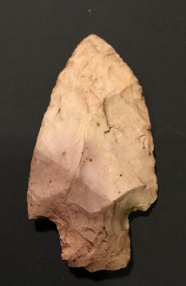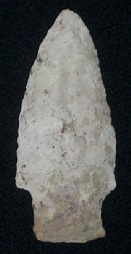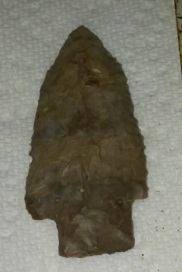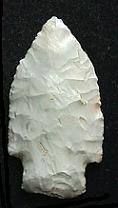Outline is Representative of Size and Shape:
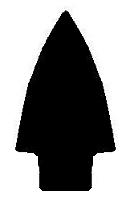
Name Details:
Identified By: Richard A. Marshall
Named For:
Date Identified: 1958
Type Site: Table Rock Reservoir, Missouri
Identified By: Richard A. Marshall
Named For:
Date Identified: 1958
Type Site: Table Rock Reservoir, Missouri
Point Validity:
Valid type
Marshall identified this point while working on his M.A. Thesis at University of Missouri. He identified e Square Stem point, . Both of which has been identified as a Smith type at various points of re-sharpening. This point was named in his M.A. Thesis and this type does have professional references, but most they generally are discussing the Smith type.
Marshall identified this point while working on his M.A. Thesis at University of Missouri. He identified e Square Stem point, . Both of which has been identified as a Smith type at various points of re-sharpening. This point was named in his M.A. Thesis and this type does have professional references, but most they generally are discussing the Smith type.
Stone Square Stem
Cluster: Etley Cluster Description of Physical Characteristics and Flaking Pattern:
This is a medium to large triangular stemmed point with a flattened to elliptical cross section. The blade may range from excurvate to an outward recurvate shape. The shoulders may range from weak to prominent and may vary from horizontal to slightly barbed. The stem is straight with a straight to slightly convex base. This point has a random flaking pattern.
Size Measurements:
Total Length - 50 to 120 mm (average 65 to 75mm), Stem Length - 10 to 16 mm, Blade Width - 24 to 40 mm (average 30 to 35 mm), Stem Width at Shoulders - 15 to 20 mm, Thickness - 7 to 10 mm
Total Length - 50 to 120 mm (average 65 to 75mm), Stem Length - 10 to 16 mm, Blade Width - 24 to 40 mm (average 30 to 35 mm), Stem Width at Shoulders - 15 to 20 mm, Thickness - 7 to 10 mm
Commonly Utilized Material:
Additional Comments:
Marshall named the Stone Square Stem and the Barry Square Stem (name rarely used) point based on examples from the same study,. It has been argued that both points were Smith type point that were in various stages of re-sharpening. It was felt that this is a Smith point that has been re-sharpened to the point that the shoulders were obliterated. This point may be found in association with Smith points (Ray 2010).
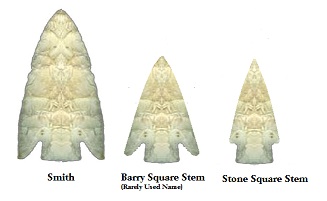
Marshall named the Stone Square Stem and the Barry Square Stem (name rarely used) point based on examples from the same study,. It has been argued that both points were Smith type point that were in various stages of re-sharpening. It was felt that this is a Smith point that has been re-sharpened to the point that the shoulders were obliterated. This point may be found in association with Smith points (Ray 2010).

Distribution: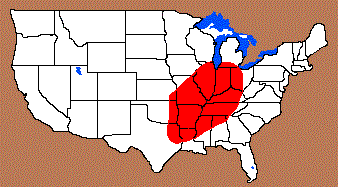

Distribution Comments:
This point has the heaviest concentration in the lower Ohio River valley and into the mid Mississippi River valley. This point may have the same distribution of the Smith point (see additional comments).
This point has the heaviest concentration in the lower Ohio River valley and into the mid Mississippi River valley. This point may have the same distribution of the Smith point (see additional comments).
Age / Periods:
Date: 6,000 - 4,000 B.P.
Cultural Period: Middle Archaic
Glacial Period: Middle Holocene
Culture:
Date: 6,000 - 4,000 B.P.
Cultural Period: Middle Archaic
Glacial Period: Middle Holocene
Culture:
Age Details:

